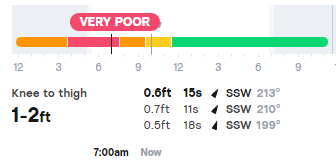When is the Best Time of Day to Surf?
“When is the best time to surf?” is a question we get daily.
We really feel for these type-A go-getters who are looking to optimize every part of their first time surfing. The bad news is surf is very hard to predict, especially weeks or months out. The good news is, we only do lessons in adequate conditions, and we rarely have to cancel.
The surf conditions are impacted by three main factors — swell, tide, and wind — and these factors vary day-to-day. But in general, the earlier lessons (8am & 10am) have the highest probability of being the best time of day. However, this is not always true, and even when it is true, the difference between the morning and afternoon is usually minor.
But if you’d like to learn more about the factors that go into our decisions, read on!
What Makes Good Surf Conditions?
The surf conditions are impacted by three main factors: swell, tide, and wind.
Swell
“Swell” is the measure of open-ocean waves propagating towards the surf location. Swell is measured by direction (NSWE), amplitude (height) and frequency (described as “period”). The swell tells us how much wave energy we should be expecting at the surf break.
At our surf lesson break, we’re sheltered by an outer reef. So the waves never get bigger than 4ft faces (and even that is a very rare day).
Tide
The tide has a major impact on the surf, as waves only break when they move from deep to shallow water. If the tide is too high, the waves won’t break and we don’t have anything to surf.
If the tide is too low, it might be too shallow to surf our popular breaks.
For optimal conditions, we prefer a low to medium rising tide.
Wind
For surf conditions, wind is the biggest factor. A big swell and a medium tide are no match for powerful onshore wind.
For perfect surf, we prefer either no wind, or light wind blowing from the beach towards the ocean (we call this wind “offshore”). If the wind is blowing parallel to the beach, we call it “sideshore” wind. And if it’s coming from the ocean towards the beach we call it “onshore” wind.
Strong wind — especially sideshore or onshore — is the real reason we have to cancel lessons in bad weather. It makes the waves unrideable, and sometimes dangerous.
For optimal conditions we want the wind to be dead, or light (<15mph) offshore wind.
How Rain Impacts Surfing
Here’s something that surprises most first-timers: rain alone does not impact surfing 🙂. In fact, rain often makes for the best surfing conditions because it dampens the wind!
We do not cancel lessons for rain unless the rain is accompanied by bad wind. Some of the best days we have are when there’s sporadic light rain.
Surf Reports & Surf Forecasting
Customers often ask if they should switch their lesson time because a surf forecasting app predicts that a certain time of day will be better. For example:

We do not recommend paying attention to online surf reports for two reasons:
- They’re often inaccurate, and
- The conditions don’t really apply to what we do on surf lessons.
Surf Forecasts are Inaccurate
Predicting surf conditions is very difficult. Surfline and other apps do the best job they can of piecing together (very few) data points to make a prediction. But the truth is, they’re often wrong. They’re best used as estimates of swell height. Everything else is too multi-factored.
If you sit around the shore near a popular surf break, you’ll notice people checking the waves all day. This isn’t because they don’t know about surf forecasting apps, it’s because they can’t rely on them.
It Isn’t Applicable to Our Lessons
Besides not being accurate, surf forecasts are not applicable to our lessons.
First, we do lessons at an inner break, protected on the outside by a reef. So swell energy is essentially standardized by the time it reaches our lesson area. Even if the swell energy is 12ft, where we take beginners will only see waves that are 3-4ft.
Second, for first-timers, conditions are not very important. For example, if the forecasting app says “poor” conditions. It’s probably referencing the quality of the face of the wave, going down the line. This matters to an experienced surfer, because they want to have long, smooth-faced, steep waves.
But for a beginner, you’re only going straight on waves, and won’t be impacted by these details.
Summary
In summary, the morning times have the highest likelihood of being better.
But it’s not always true and the differences between times are minimal.
At Stoke Drift, we don’t do lessons unless the waves are good 🙂 so rest assured anytime will work!
